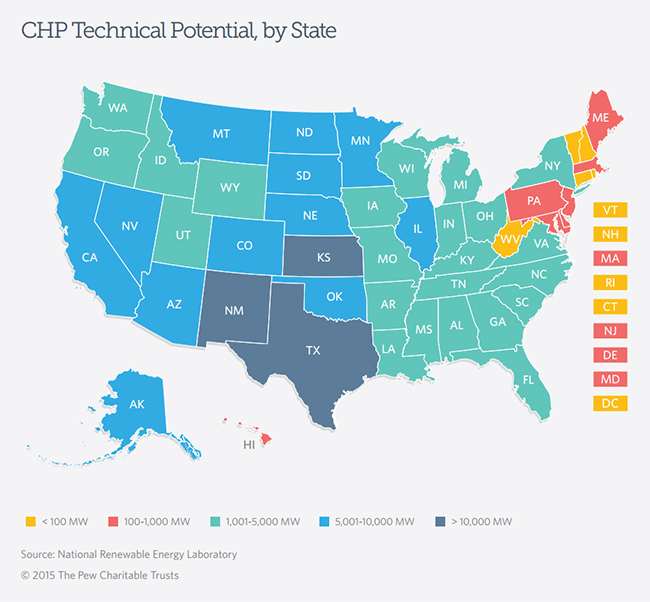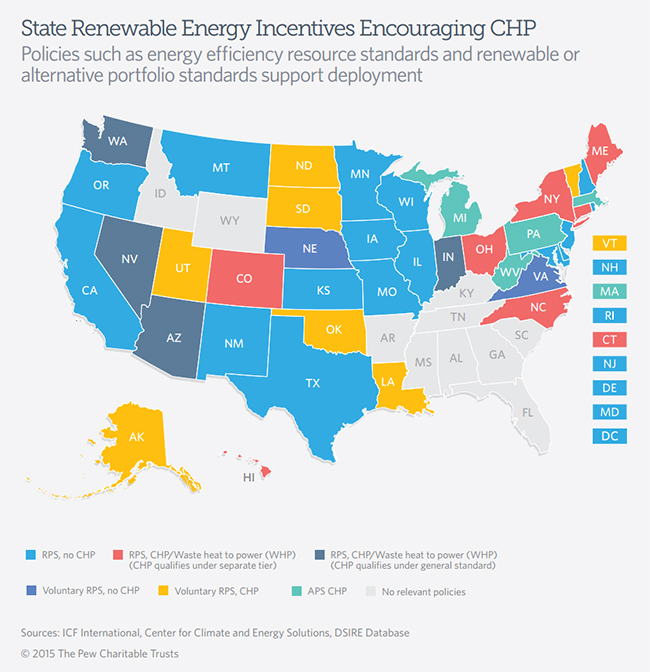10 Reasons States Should Include CHP in Clean Power Plans
Overview
To comply with the U.S. Environmental Protection Agency’s proposed rules for reducing greenhouse gas emissions from existing power plants, generators will need to embrace a range of renewable and energy efficiency technologies. Combined heat and power systems, known as CHP, capture waste heat from manufacturing and other industrial processes and use it to generate electricity or to heat or cool nearby buildings, providing significant efficiency benefits, cost savings, and reduced emissions.
The agency’s proposal, the Clean Power Plan, assigns a specific emissions reduction goal to every state and requires each to develop and implement plans to meet those targets. The current draft rule does not explicitly identify CHP as technology that can help states achieve the goals. Following are the top 10 reasons why CHP is a cost-effective solution that states should consider and that the EPA should recognize in its final rule.1
10: CHP potential exists in every state
Although renewable resources vary significantly by geography, CHP can provide efficiency across the country, regardless of the mix of energy resources. CHP, which is flexible and scalable, can be applied at a wide range of industrial, commercial, and institutional facilities that require round-the-clock power, such as manufacturing plants and hospitals. It is also highly useful in areas with low heating and high cooling requirements by converting otherwise wasted heat into air conditioning.
9: CHP allows industries to better compete in the global economy
Energy-intensive U.S. industries compete better in the global marketplace when they can lower operational costs, which investments in CHP can support. Sectors such as chemical, iron and steel, nonmetallic minerals, refining, and pulp and paper can benefit from these highly efficient systems.

8: CHP improves grid reliability by reducing peak load
Because CHP facilities are typically located on-site or close to consumers, electricity transmission and distribution losses are reduced and delivery constraints are relieved. Projects are commonly integrated with district energy operations, which power multiple buildings, allowing generators to respond as power demands vary.
7: CHP enhances energy security and resiliency
Compared with large, interconnected grids, CHP is more resilient when weather or security events interrupt energy supplies. Many facilities can come online quickly after outages and can operate off the grid during a blackout. These attributes allow businesses to keep the lights on and to keep critical infrastructure powered and operations running.
6: CHP deployment can be facilitated through integrated resource planning
Integrated resource planning helps monetize the benefits of CHP that do not currently have a market value, such as reduced emissions and increased resiliency and efficiency, enabling planners to account for all of the technology’s advantages.
5: CHP contributes to state targets for energy savings
An energy efficiency resource standard requires utilities to develop a plan to achieve a certain amount of savings every year. CHP can help electricity providers meet savings targets through reduced consumption and increased efficiency.
4: CHP can be a component of a renewable, or alternative, portfolio standard
Renewable, or alternative, portfolio requirements specify that a state must obtain a percentage of its electricity from clean and efficient resources. Depending on how the standards are constructed, CHP can qualify.
3: CHP deployment is viable in every state
When CHP systems have parity with conventional power generation in financial incentives, interconnection, or power purchase agreements, the technology becomes viable in every state. Across the country, utilities are beginning to embrace these highly efficient systems and to effectively plan for their incorporation, thereby spurring more widespread deployment.

2: CHP is the backbone of district energy systems
CHP is a key component of district energy systems that produce steam and hot or chilled water at a central plant to heat or cool entire complexes, such as university campuses, office parks, or urban centers. Increasing efficiency and reducing fuel consumption at such a large scale is cost-effective.
Each year, U.S. utilities and factories send enough heat up their chimneys to power all of Japan.Oak Ridge National Laboratory
1: CHP reduces energy waste
Annually, a staggering 25 percent of total U.S. energy use is wasted through inefficiencies in generation technologies and transmission. CHP offers states an opportunity for higher efficiency, lower emissions, increased savings, and compliance with the proposed Clean Power Plan.
Endnotes
- This document relies heavily on: International District Energy Association, District Energy magazine (fourth quarter 2014), 59–62, http://www.districtenergy-digital.org/districtenergy/2014Q4#pg61 (Subscription Required).






